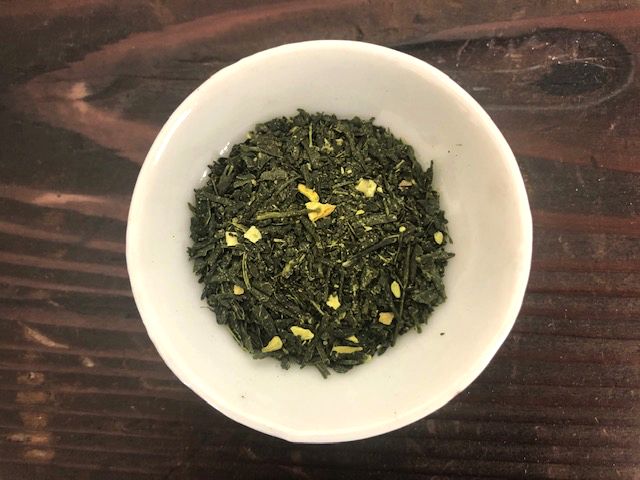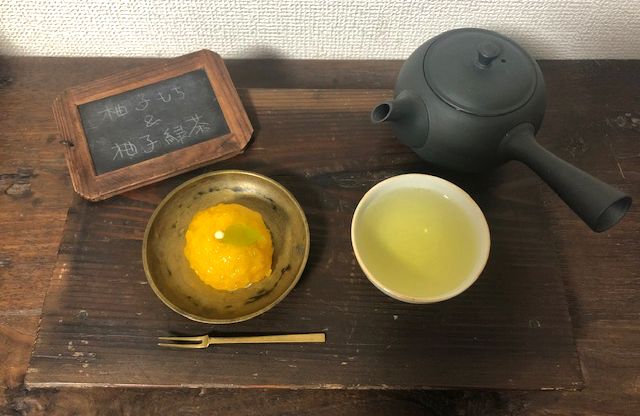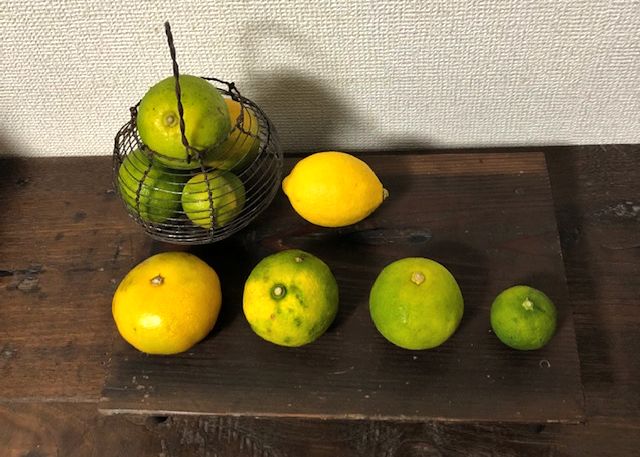October 2020 – Yuzu-Ryokucha
Finally the colors of the autumn are spreading throughout Japan. We selected a Yuzu-Ryokucha (ゆず緑茶), a green tea in Shizuoka (静岡) mixed yuzu chips in Tokushima (徳島) this month.

Yuzu-Ryokucha
Yuzu-Ryokucha (ゆず緑茶) is a green tea flavored with chips of dried yuzu. We use green tea from the region called Kakegawa (掛川) of Shizuoka and steam them by means of "Fukamushi (深蒸し)", that is to say by steaming tea leaves for twice as long as a classic Sencha (煎茶). This method of production results in a sweet, rich tea with a deep taste.
Compared to a classic Sencha, Fukamushicha (深蒸し茶) has finer tea leaves and contains lots of tea powder. Therefore, we can assimilate lots of elements distilled from the tea, such as catechin, theanine, vitamin C, dietary fiber and minerals. And then, we should not forget the yuzu chips, picked in Tokushima on the island of Shikoku (四国). Yuzu washes away the bitterness of green tea, and leave a pleasant aftertaste.

Yuzu-Ryokucha with Yuzu rice cake (柚子餅)
Unfortunately, I couldn't get the actual yuzu used to prepare this tea. However, I could imagine yuzu thanks to this cake. That was a perfect combination of three senses: sight, smell and taste. I was 100% in the yuzu world while tasting this tea! Try to drink Yuzu-Ryokucha while imagining a real yuzu!
Yuzu & Friends
Can you identify the Yuzu among these citrus fruits?

Except for lemon (top) and clementine (lower left), it is quite difficult to find the correct one, because they look pretty similar. These fruits, except for the lemon (that came from New Zealand) are picked in the southern areas of Japan, especially in Shikoku (四国) or Kyushu (九州). They are currently in season, during fall and winter.
Now back on topic. How can we distinguish these three citrus fruits: Yuzu (ゆず), Kabosu (かぼす) and Sudachi (すだち)? First of all, we can eliminate sudachi, which is smaller than the other two and has the size of golf ball. After that, what is the difference between yuzu and kabosu? We can distinguish them by their texture. Yuzu is rougher and it has more pimples than kabosu.
Yuzu is very useful and used in lots of products: a soy sauce called ponzu (ポン酢), seasonings, sweets, soap, bath salt, etc. This is because yuzu is sweeter and more flavorful than the two other citrus fruits. Frankly speaking, yuzu doesn't have a good appearance. However, you should not judge yuzu like this. The exterior is less important than the interior.
As the little prince say in the story, "What is essential is invisible to the eye, but palpable to the taste". Oh no, he does not say that? Sorry! So the answer is the second one from left. From the left: Mikan (Japanese clementine), Yuzu, Kabosu and Sudachi.
Brewing Yuzu-Ryokucha
The amount of tea leaves should be adapted according to the desired taste: it should be around 7 grams of Yuzu-Ryokucha for 200ml (7oz) of spring water. The infusion should last 30 seconds in boiling water. The second infusion should be done more quickly than the first one. Enjoy your tea!
If you have questions about Japanese teas, please do not hesitate to contact us!
